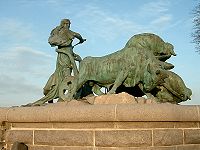
Plough
A plough or plow (US; both /plaʊ/) is a farm tool for loosening or turning the soil before sowing seed or planting.[1] Ploughs were traditionally drawn by oxen and horses but in modern farms are drawn by tractors. A plough may have a wooden, iron or steel frame with a blade attached to cut and loosen the soil. It has been fundamental to farming for most of history.[2] The earliest ploughs had no wheels; such a plough was known to the Romans as an aratrum. Celtic peoples first came to use wheeled ploughs in the Roman era.[3]
Not to be confused with PLO.
The prime purpose of ploughing is to turn over the uppermost soil,[4] bringing fresh nutrients to the surface[5] while burying weeds and crop remains to decay. Trenches cut by the plough are called furrows. In modern use, a ploughed field is normally left to dry and then harrowed before planting. Ploughing and cultivating soil evens the content of the upper 12 to 25 centimetres (5 to 10 in) layer of soil, where most plant feeder roots grow.
Ploughs were initially powered by humans, but the use of farm animals is considerably more efficient. The earliest animals worked were oxen. Later, horses and mules were used in many areas. With the Industrial Revolution came the possibility of steam engines to pull ploughs. These in turn were superseded by internal-combustion-powered tractors in the early 20th century. The Petty Plough was a notable invention for ploughing out orchard strips in Australia in the 1930s.
Use of the traditional plough has decreased in some areas threatened by soil damage and erosion. Used instead is shallower ploughing or other less-invasive conservation tillage.
The plough appears in one of the oldest surviving pieces of written literature, from the 3rd millennium BC, where it is personified and debating with another tool, the hoe, over which is better: a Sumerian disputation poem known as the Debate between the hoe and the plough.[6]
Etymology[edit]
In older English, as in other Germanic languages, the plough was traditionally known by other names, e.g. Old English sulh (modern dialectal sullow), Old High German medela, geiza, huohilī(n), Old Norse arðr (Swedish årder), and Gothic hōha, all presumably referring to the ard (scratch plough).
The modern word comes from the Old Norse plógr, and is therefore Germanic, but it appears relatively late (it is not attested in Gothic) and is thought to be a loan from one of the north Italic languages. The German cognate is "pflug", the Dutch "ploeg" and the Swedish "plog". In many Slavic languages and in Romanian the word is "plug". Words with the same root appeared with related meanings: in Raetic plaumorati "wheeled heavy plough" (Pliny, Nat. Hist. 18, 172), and in Latin plaustrum "farm cart", plōstrum, plōstellum "cart", and plōxenum, plōximum "cart box".[7][8] The word must have originally referred to the wheeled heavy plough, common in Roman north-western Europe by the 5th century AD.[9]
Many view plough as a derivative of the verb *plehan ~ *plegan 'to take responsibility' (cf. German pflegen 'to look after, nurse'), which would explain, for example, Old High German pfluog with its double meaning of 'plough' and 'livelihood'.[10][11][12] Guus Kroonen (2013)[13] proposes a vṛddhi-derivative of *plag/kkōn 'sod' (cf. Dutch plag 'sod', Old Norse plagg 'cloth', Middle High German pflacke 'rag, patch, stain'). Finally, Vladimir Orel (2003)[14] tentatively attaches plough to a PIE stem *blōkó-, which supposedly gave Old Armenian peɫem "to dig" and Welsh bwlch "crack", though the word may not be of Indo-European origin.[15]
Specialist ploughs[edit]
Chisel plough[edit]
The chisel plough is a common tool for deep tillage (prepared land) with limited soil disruption. Its main function is to loosen and aerate the soils, while leaving crop residue on top. This plough can be used to reduce the effects of soil compaction and to help break up ploughpan and hardpan. Unlike many other ploughs, the chisel will not invert or turn the soil. This feature has made it a useful addition to no-till and low-till farming practices that attempt to maximise the erosion-preventing benefits of keeping organic matter and farming residues present on the soil surface throughout the year. Thus the chisel plough is considered by some to be more sustainable than other types of plough, such as the mould-board plough.
Effects of mould-board ploughing[edit]
Mould-board ploughing in cold and temperate climates, down to 20 cm (7.9 in), aerates the soil by loosening it. It incorporates crop residues, solid manures, limestone and commercial fertilisers alongside oxygen, so reducing nitrogen losses by denitrification, accelerating mineralisation and raising short-term nitrogen availability for turning organic matter into humus. It erases wheel tracks and ruts from harvesting equipment. It controls many perennial weeds and delays the growth of others until spring. It accelerates spring soil warming and water evaporation due to lower residues on the soil surface. It facilitates seeding with a lighter seed, controls many crop enemies (slugs, crane flies, seedcorn maggots-bean seed flies, borers), and raises the number of "soil-eating" earthworms (endogic), but deters vertical-dwelling earthworms (anecic).
Ploughing leaves little crop residue on the surface that might otherwise reduce both wind and water erosion. Over-ploughing can lead to the formation of hardpan. Typically, farmers break that up with a subsoiler, which acts as a long, sharp knife slicing through the hardened layer of soil deep below the surface. Soil erosion due to improper land and plough utilisation is possible. Contour ploughing mitigates soil erosion by ploughing across a slope, along elevation lines. Alternatives to ploughing, such as a no-till method, have the potential to build soil levels and humus. These may be suitable for smaller, intensively cultivated plots and for farming on poor, shallow or degraded soils that ploughing would further degrade.









